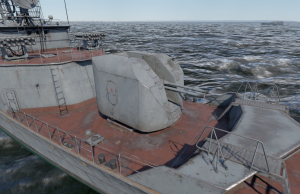Difference between revisions of "AK-726 (76 mm)"
Colok76286 (talk | contribs) |
Colok76286 (talk | contribs) |
||
| Line 34: | Line 34: | ||
== History == | == History == | ||
| − | The AK-726 was developed between 1954 and 1959 as the ZIF-67. It successfully went through extensive trials in 1958-59 and then through shipboard trials in 1960-62. Production started in 1963 with a total of 104 mounts being manufactured between 1958 and 1964. In 1962 the first gun was installed on the ''Groznyy'' cruiser. A second was installed on the ''Komsomolets Ukrainy'' destroyer. The system was officially launched on June 24, 1964. The guns were exported to various Eastern Bloc states over time. Due to the small caliber and lack of effectiveness they were soon replaced by | + | The AK-726 was developed between 1954 and 1959 as the ZIF-67. It successfully went through extensive trials in 1958-59 and then through shipboard trials in 1960-62. Production started in 1963 with a total of 104 mounts being manufactured between 1958 and 1964. In 1962 the first gun was installed on the ''Groznyy'' cruiser. A second was installed on the ''Komsomolets Ukrainy'' destroyer. The system was officially launched on June 24, 1964. The guns were exported to various Eastern Bloc states over time. Due to the small caliber and lack of effectiveness they were soon replaced by the AK-100.<ref>https://en.wikipedia.org/wiki/AK-726</ref> |
This weapon was operated by a Fut-B control system which could control the guns against aircraft flying at speeds from 1,150 to 1,780 fps (350 to 650 mps) and at altitudes from 1,650 to 19,700 feet (500 to 6,000 m) and at ranges of up to 11 miles (18.3 km). It could also be used against ship targets at ranges up to 5 miles (8.2 km). | This weapon was operated by a Fut-B control system which could control the guns against aircraft flying at speeds from 1,150 to 1,780 fps (350 to 650 mps) and at altitudes from 1,650 to 19,700 feet (500 to 6,000 m) and at ranges of up to 11 miles (18.3 km). It could also be used against ship targets at ranges up to 5 miles (8.2 km). | ||
Revision as of 08:20, 11 May 2023

Contents
Description
Write an introduction to the article in 2-3 small paragraphs. Briefly tell us about the history of the development and combat using the weaponry and also about its features. Compile a list of air, ground, or naval vehicles that feature this weapon system in the game.
Vehicles equipped with this weapon
General info
Tell us about the tactical and technical characteristics of the cannon or machine gun.
Available ammunition
Describe the shells that are available for the weapon and their features and purpose. If it concerns autocannons or machine guns, write about different ammo belts and what is inside (which types of shells).
Comparison with analogues
Give a comparative description of cannons/machine guns that have firepower equal to this weapon.
Usage in battles
Describe the cannon/machine gun in the game - its distinctive features, tactics of usage against notable opponents. Please don't write a "guide" - do not impose a single point of view, but give the reader food for thought.
Pros and cons
Summarise and briefly evaluate the weaponry in terms of its characteristics and combat effectiveness. Mark pros and cons as a list.
Pros:
Cons:
History
The AK-726 was developed between 1954 and 1959 as the ZIF-67. It successfully went through extensive trials in 1958-59 and then through shipboard trials in 1960-62. Production started in 1963 with a total of 104 mounts being manufactured between 1958 and 1964. In 1962 the first gun was installed on the Groznyy cruiser. A second was installed on the Komsomolets Ukrainy destroyer. The system was officially launched on June 24, 1964. The guns were exported to various Eastern Bloc states over time. Due to the small caliber and lack of effectiveness they were soon replaced by the AK-100.[1]
This weapon was operated by a Fut-B control system which could control the guns against aircraft flying at speeds from 1,150 to 1,780 fps (350 to 650 mps) and at altitudes from 1,650 to 19,700 feet (500 to 6,000 m) and at ranges of up to 11 miles (18.3 km). It could also be used against ship targets at ranges up to 5 miles (8.2 km).
It used a monobloc barrel with spring receiver. The barrels were in a common cradle and the automatic mechanism operated from recoil forces. This gun is not water-cooled during the firing, but during breaks between firing sea water was pumped through the barrels. It usually took between two and three minutes to cool the guns. The turret has an unusually deep cleft which allowed the guns to be mounted aft of the center of the trunnion, which made them able to achieve high elevations.[2]
- analogues by other nations and research trees.
External links
Paste links to sources and external resources, such as:
- topic on the official game forum;
- other literature.



